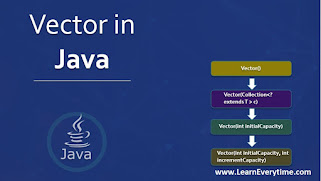Hello Everyone This is Gautam. In this Post, we will learn about the Vector class and how to use it. We will also learn how it is different from the
ArrayList class, and why we should use array lists instead.
The Vector class is an implementation of the List interface that allows us to create resizable-arrays similar to the ArrayList class.
------------------------> Java Vector vs. ArrayList <-------------------------
1. In Java, both ArrayList and Vector implements the List interface and provides the same functionalities. However, there exist some differences between them.
2. The Vector class synchronizes each individual operation. This means whenever we want to perform some operation
on vectors, the Vector class automatically applies a lock to that operation.
3. It is because when one thread is accessing a vector, and at the same time another thread tries to access it, an exception called Concurrent Modification Exception is generated. Hence, this continuous use of lock for each operation makes vectors less efficient.
4. However, in array lists, methods are not synchronized. Instead, it uses the Collections.synchronizedList() method that synchronizes the list as a whole.
Note: It is recommended to use ArrayList in place of Vector because vectors are not threadsafe and are less efficient.
<----------------------------------------------------------->
___ Creating a Vector ___
-->Here is how we can create vectors in Java.
Vector<Type> vector = new Vector<>();
Here, Type indicates the type of a linked list.
For example,
// create Integer type linked list
Vector<Integer> vector= new Vector<>();
// create String type linked list
Vector<String> vector= new Vector<>();
Methods of Vector
The Vector class also provides the resizable-array implementations of the List interface (similar to the ArrayList class).
Some of the Vector methods are:
Add Elements to Vector
add(element) - adds an element to vectors
add(index, element) - adds an element to the specified position
addAll(vector) - adds all elements of a vector to another vector
For example,
import java.util.Vector;
class Main
{
public static void main(String[] args)
{
Vector<String> mammals= new Vector<>();
// Using the add() method
mammals.add("Dog");
mammals.add("Horse");
// Using index number
mammals.add(2, "Cat");
System.out.println("Vector: " + mammals);
// Using addAll() ;
Vector<String> animals = new Vector<>();
animals.add("Crocodile");
animals.addAll(mammals);
System.out.println("New Vector: " + animals);
}
}
Output
Vector: [Dog, Horse, Cat]
New Vector: [Crocodile, Dog, Horse, Cat]
Access Vector Elements
get(index) - returns an element specified by the index
iterator() - returns an iterator object to sequentially access vector elements
For example,
import java.util.Iterator;
import java.util.Vector;
class Main
{
public static void main(String[] args)
{
Vector<String> animals= new Vector<>();
animals.add("Dog");
animals.add("Horse");
animals.add("Cat");
// Using get()
String element = animals.get(2);
System.out.println("Element at index 2: " + element);
// Using iterator()
Iterator<String> iterate = animals.iterator();
System.out.print("Vector: ");
while(iterate.hasNext())
{
System.out.print(iterate.next());
System.out.print(", ");
}
}
}
Output
Element at index 2: Cat
Vector: Dog, Horse, Cat,
Remove Vector Elements
remove(index) - removes an element from specified position
removeAll() - removes all the elements
clear() - removes all elements. It is more efficient than removeAll()
For example,
import java.util.Vector;
class Main
{
public static void main(String[] args)
{
Vector<String> animals= new Vector<>();
animals.add("Dog");
animals.add("Horse");
animals.add("Cat");
System.out.println("Initial Vector: " + animals);
// Using remove();
String element = animals.remove(1);
System.out.println("Removed Element: " + element);
System.out.println("New Vector: " + animals);
// Using clear()
animals.clear();
System.out.println("Vector after clear(): " + animals);
}
}
Output
--> Initial Vector: [Dog, Horse, Cat]
--> Removed Element: Horse
--> New Vector: [Dog, Cat]
--> Vector after clear(): []
--> Others Vector Methods
--> Methods Descriptions
--> set() changes an element of the vector
--> size() returns the size of the vector
--> toArray() converts the vector into an array
--> toString() converts the vector into a String
--> contains() searches the vector for specified element and returns a boolean result.
Social media link:
Please Follow me in Instagram:- Click Here
Please Follow me and Share this page
THANKS FOR VISITING THIS BLOG PAGE 💖.


0 Comments